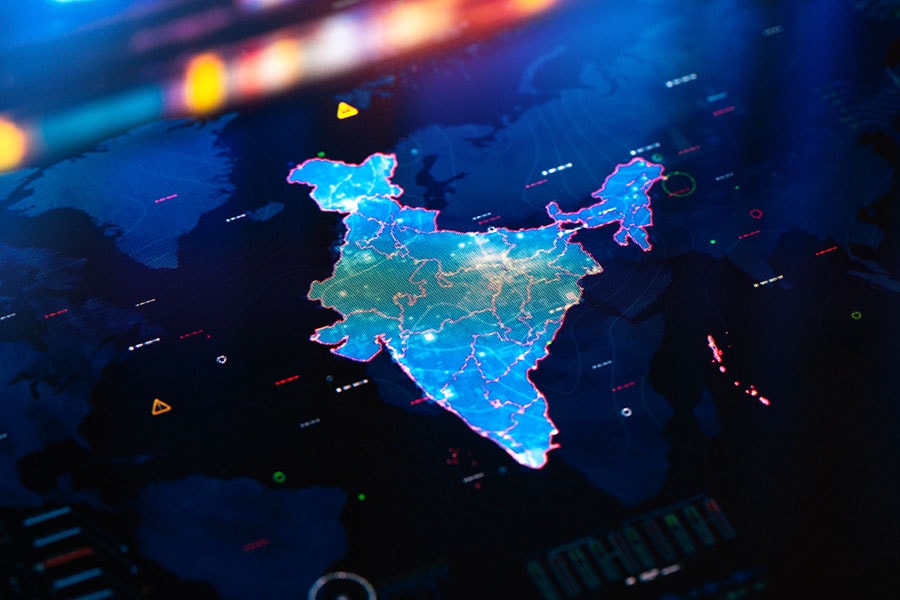Digital India Programme: A journey of transformation
In the last nine years, the Digital India programme has made significant strides in enhancing digital infrastructure, providing accessible government services, and empowering citizens by leveraging technology
 In the last nine years, the Digital India programme has made significant strides in enhancing digital infrastructure, providing accessible government services, and empowering citizens by leveraging technology.
Image: Getty Images
In the last nine years, the Digital India programme has made significant strides in enhancing digital infrastructure, providing accessible government services, and empowering citizens by leveraging technology.
Image: Getty Images
Advancements in technology and telecommunication continue to be a primary catalyst for change in the digital ecosystem and the way we do business today. Digitisation has helped companies, governments, and social sector institutions increase their productivity, reinvent their offerings, and contribute to society's well-being.
In the last nine years, the Digital India programme has made significant strides in enhancing digital infrastructure, providing accessible government services, and empowering citizens by leveraging technology. This initiative has played a crucial role in driving India towards becoming a digitally inclusive society and boosting its economy through innovation and connectivity. As of September 2023, Aadhaar provides online-based digital identity to around 1.3 billion.
Another layer of the Digital Indian Stack is the Unified Payment Infrastructure (UPI). With 598 institutions on the network, the UPI has processed 14,035.84 million payments as of May 2024. With over 330 million unique users as of September 2023, the UPI network has become India's largest digital payment network and the world's fifth-largest digital payment network by volume in less than a decade. The UPI set a record by processing 14.04 billion transactions in May 2024, from one million transactions in 2016, and its growth demonstrates how the UPI has revolutionised the digital payment environment by offering a simple and convenient option. The UPI transactions have grown at a Compound Annual Growth Rate (CAGR) of 147 percent in terms of volume and grown at a CAGR of 168 percent from 2017-2018 (92 crores) to 2022-2023 (8375 crores) and have been the major driving force in the overall growth of digital payment transactions in the country accounting for 62 percent of digital payment transactions in FY 2022-23.
The creation of the Aarogya Setu mobile application was an economical and innovative approach during the COVID-19 pandemic. It could reach large populations in both urban and rural India at a fast pace and in a short duration. The application notified users about the people in close proximity suffering from COVID-19. It provided information on COVID-19 updates, self-assessment tools, helpline numbers, and other resources to help individuals stay informed and take necessary precautions during the pandemic. To monitor the vaccination drive in a country with 1.5 billion people. Technology again came to the aid, and the Government of India launched the Co-Win Mobile App to monitor the vaccination drive. As of November 2023, over 220.67 crore vaccinations and over 110.93 crore registrations have been administered.
Empowering citizens is at the heart of Digital India. The provision of accessible and affordable healthcare stands as a cornerstone of societal well-being and economic development. The Ayushman Bharat Digital Mission (ADBM) has facilitated easier access to medical consultations and health information management through telemedicine services and digital health records, lower medication costs due to the availability of generic drugs, and reduced physical visits to healthcare facilities. It has generated 620 million accounts and linked approximately 390 million health records.
Additionally, 285,000 health facilities and 376000 healthcare professionals have registered with the programme: eSanjeevani, India's National Telemedicine Service, the world's largest telemedicine operation in primary care. By May 7, 2024, it has facilitated over 241 million patient treatments across 122,699 Health & Wellness Centres through 15,460+ hubs and 372 online Outpatient Departments. It has provided more than ten crore teleconsultations, benefiting primarily women (57 percent) and older people (12 percent).
UMANG application empowers 50 million users to over 170 government services, while e-hospital simplifies healthcare access for over 380 million registered patients. Pradhan Mantri Gramin Digital Saksharta Abhiyan (PMGDISHA) is the world's largest digital literacy drive, equipping rural communities with essential digital skills like e-commerce, finance, and cyber-security. Under the scheme, 438570 training centres in India have certified 47 million trainees.
SWAYAM platform offers online courses designed and delivered by eminent faculties from institutes of eminence and reputes in India. The platform has helped students from rural India learn from leading faculty members from different institutions nationally. eNAM, an agricultural platform that integrates 1,389 mandis across 23 states and 4 Union Territories, facilitating access from a wide range of stakeholders, including traders, farmers, commission agents, Farmer Producer Organisations, and service providers, totalling 181,22,367 participants as of May 31, 2024.
Also read: The Data Dilemma: Balancing government needs and privacy in the digital age
India's core digital economy shares in Gross value added (GVA) increased from 5.4 percent in 2014 to 8.5 percent in 2019, and it has grown at a CAGR of more than 15 percent from $196 billion to over $225 billion in FY22. The shift towards online platforms has significantly reduced paperwork, minimised bureaucratic hurdles, and expedited decision-making processes. Online platforms have also empowered citizens by giving them easier access to information, services, and opportunities for participation in the governance process. While emerging technologies have played a key role in transforming India into a digitally empowered society, several challenges have been encountered, such as cyber-attacks and threats, data privacy and protection and responsible use of the new age technologies.
To effectively address the challenges faced by the Digital India programme, several strategies and initiatives need to be implemented, such as:
- Improving Digital Infrastructure in rural and underserved areas;
- Implementing cyber security measures to strengthen cybersecurity protocols and practices to safeguard digital systems and data from cyber threats;
- Enforce privacy regulations and framework to ensure the protection of citizen's data;
- Regularly monitor and evaluate the performance of the Digital India programme to identify gaps, challenges, and areas for improvement and implement feedback mechanisms to address issues promptly;
- Foster collaborations with the private sector, academia, and civil society to leverage expertise, resources, and innovation to overcome the programme's challenges.
By implementing these strategies and initiatives, the Digital India programme can better navigate the challenges it faces and drive towards its goal of creating a digitally inclusive society and a knowledge-based economy. Collaboration, innovation, investment, and a citizen-centric approach will be key in successfully countering the challenges encountered along the digital transformation journey.
Dr. Shruti Mantri, Associate Director, ISB Institute of Data Science
Mr. Ramesh Kotnana, Senior Manager, ISB Centre for Business Innovation
[This article has been reproduced with permission from the Indian School of Business, India]

















